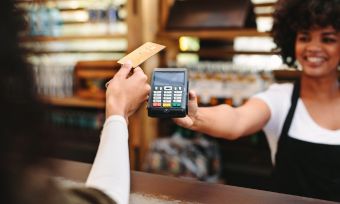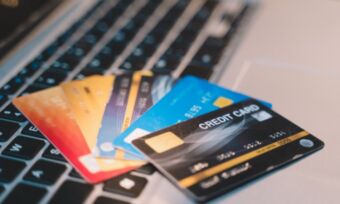What is a digital wallet? 5 tips to help you choose one
Digital wallets allow you to store banking information, identity documents and other information on your mobile device. So how do they work?

Digital wallets allow you to store banking information, identity documents and other information on your mobile device. So how do they work?
Key points:
- A digital wallet can store anything from credit and debit cards to tickets and boarding passes.
- Some digital wallets allow any compatible card to be stored, but some are more restrictive.
- Cards stored in your digital wallet can typically be used where contactless payment is provided.
What is a digital wallet?
A digital wallet (known on mobile devices as a mobile wallet) is an app or service that allows users to store payment information, transfer funds or make transactions. Although they can be used on a desktop, they’re typically an app on a mobile device that can be easily accessed by the user. Just like you would open a physical wallet to grab a credit card when paying for something, you can open the digital wallet app to access your digitally stored credit card. You can also store things like access cards and movie tickets.
When choosing a digital wallet, keep in mind that you may not be covered by the same protections you get when using a physical bank card. Be sure to read the terms and conditions of the app you choose, as well as your financial institution’s policies, before you start using it for transactions.
What can I store in a digital wallet?
A digital wallet lets a user store a range of information electronically, which they can access on demand via the app or device. Information that can be stored in a digital wallet could include:
- Credit and debit cards.
- Identity documents, such as the COVID-19 vaccination certificate.
- Health fund cards.
- Loyalty and gift cards.
- Tickets to events or movies.
- Boarding passes.
- e-keys, such as for a car, home or hotel room.
However, not all of these things can be downloaded to all digital wallets – they have to be programmed, enabled or authorised to be added. It could depend on what bank you are with or what company has issued the tickets, and it could also depend on what digital wallet you choose and your brand of mobile device.
Increasingly, government IDs and documents – like a Medicare card – are going digital. These cards can typically be stored within a dedicated app (such as MyGov apps’ wallet). These documents are often not able to be uploaded to other digital wallets, such as your phone’s default wallet, due to security reasons.
How do digital wallets work?
All digital wallets store information on a mobile device, but not all digital wallets operate in the same way. That’s because typically there are three different layers of technology at work.
- The digital wallet app is the application (app) or program that stores your information, cards, etc, digitally.
- The compatible mobile payment system allows you to use the information in the wallet, such as your credit card, to pay for items or transfer money to someone else.
- The mobile phone’s hardware such as a built-in Near Field Communications (NFC) antenna. This allows the payment system to communicate with payment networks and allow contactless payment.
Wallet items that don’t work with or don’t need a payment system, such as event tickets or boarding passes, use various methods to allow the digital information to be verified in the real world. For example, if you’ve stored a movie ticket, the wallet e-ticket may display a barcode or QR code that the cinema attendant could scan before allowing you to enter the theatre. Other options may include a unique code.
Examples of different types of digital wallets
New types of digital wallets are constantly being released. At present, the main types of digital wallets are:
- Those that allow any compatible credit/debit card and other documents to be stored in them. There are two different types: the digital wallets that allow you to use your phone to make tap-and-go payments, and those that are not connected to a tap-and-go payments system. Examples include PayPal’s Wallet function in the PayPal app or eftpos Beem It.
- Those that restrict what can be uploaded to them. This is where a brand or bank creates the digital wallet specifically for their customers and does not permit other types of digital cards or information to be stored there. Examples include some buy now pay later (BNPL), peer-to-peer lending, and banking apps such as Money by Afterpay.
- Those that only store information and cannot be used for paying for things. These wallets may offer the option to store images of debit/credit cards, but are not compatible with any payment system. They may, however, hold items such as gift cards, loyalty cards, and tickets. These can be redeemed online or in real life via a QR code, barcode or other method. Examples include loyalty card wallet Stocard, gift card digital wallet Prezzee and event ticket apps such as Ticketek or Event Cinema.
How do I make payments using a digital wallet?
To enable payments to be made via a digital wallet:
- Choose what digital wallet you want. If your mobile device comes with a built-in digital wallet, you may choose to use this. Or you could download one from the app store.
- Add a compatible credit or debit card (like a Visa or Mastercard) to the wallet. There are some digital wallets that allow you to load money/credit directly into them too, although they are typically known as e-wallets.
- Activate when you want to pay for something, and if the store has the right equipment, you simply activate the digital wallet on your phone by tapping the app icon on your screen or clicking a button on the device
- Pay, if your wallet is attached to a payment system, you can move your device close to the payment device. Your mobile phone and the payment device then communicate, and a message will be displayed on the payment machine saying that the payment was successful or approved.
If your wallet doesn’t have a payment system attached, use the method provided by the wallet, such as a QR Code, unique code or payment transfer to pay.
Related: Virtual Credit Cards in Australia
Where can I use a digital wallet to pay for things?
You can usually use a digital wallet’s contactless payment function to pay for things anywhere that a contactless payment (tap-and-go) option is provided. Different point-of-sale payment machines have different names for this, such as PayWave or PayPass.
Why can’t I add my card in my digital wallet?
Sometimes, you may find that you can’t download a certain bank’s card into a digital wallet. Even if you can add it, you may find you’re unable to use the digital wallet to pay at some places. That’s because there are a few things that need to happen:
- The issuer of the card or ticket that you want to store may have needed to sign an agreement (and sometimes to have paid a fee) to the digital wallet/payment system provider.
- The agreement that allows the issuer to transform their card or ticket into a digital format needs to be compatible with the digital wallet.
- The issuer has to provide you with a link, code or process that allows you to download the information into the wallet.
- When you go to use the card or ticket, the place you want to use it has to have the right payment device or systems set up that are compatible.
Thankfully, most retailers now have contactless electronic payments systems that are compatible with the most common type of mobile payments (the tap-and-go variety). The majority of Australian banks have signed up to at least one or two of the major digital wallet or payment systems (Apple Pay, Google Pay and Samsung Pay) and have provided their customers with the option to upload their cards to those digital wallets.
Does using a card stored in a digital wallet cost more than using a physical card?
Whether or not using a digital wallet or mobile wallet costs more than using a physical card for purchases depends on a few things – but in some cases, yes, it could cost you more. You may not be able to choose between credit or debit functions on your card if you pay via a mobile device, and only be able to use credit. Not only does that mean every purchase could add to your credit card debt, it could also result in you paying more for the item in the form of a ‘credit card surcharge’. This is usually an additional 1% to 2% of the purchase price. Not all business owners apply the surcharge. However, you may be able to set specific cards in your wallet to use other payment methods if you have the right kind of card.
How do I choose the best digital wallet for my needs? 5 tips
Take a look at what’s in your physical wallet. What items would you like to stop carrying around and instead store on your phone? That’s where a digital wallet could help. The trick is to find one that best suits your needs. If you’re new to the concept of digital wallets, it could be helpful to ask yourself a few questions before choosing one to use:
- Is there one already on my mobile phone? Can I only use the phone’s in-built wallet? Do I need to download one? Sometimes, people choose to use the digital wallet that’s already in their phone as it combines a payment system with the digital storage function. Some phone users may only be able to use the in-built digital wallet if they want to use it for tap-and-go payments. However, some people may prefer not to use their phone provider’s payment system, or they may find a wallet that better suits their needs.
- What do I want to use it for? Do I want to pay for things with it or just store information? Some wallets offer the benefit of contactless payments, whilst others don’t offer any payment options. Instead they can hold information for things like gift cards, loyalty cards and tickets.
- Does my bank support payment through a particular digital wallet? Does the digital wallet restrict the types of cards that can be uploaded? Not all banks allow their debit or credit cards to be added to digital wallets and used with mobile phone payment systems. Alternatively the banks might only have arrangements with certain brands, such as supporting Apple Pay but not Google Pay. Some wallets might also restrict the type of payment system that you can use.
- How easy is it to use? Does it have the functions that I need? Research the usability of the wallet to ensure that it has what you need. For example, what other items are in your physical wallet that you want to offload to a digital storage device? Some wallets may even be able to be used with a wearable device, such as a smartwatch.
- Does it seem trustworthy? If you need to download a wallet, ensure you research it thoroughly as there can be risks involved in downloading apps and filling them with personal information.
Keep in mind, even if you use a digital wallet – or a few of them – it could still be a good idea to have an alternative payment method. This could be cash or a debit card, just in case your mobile device goes flat, or you have technical issues at the point of sale.
How do I download a digital wallet?
There are a few ways to install a digital wallet onto your mobile phone:
- Built-in. Some mobile phones have a digital wallet built into them. These are usually already installed when you set up your phone for the first time, or they can be re-downloaded from the applicable app store.
- Download. Whether or not you can download a digital wallet that is different to the built-in one, and use it for contactless payments, will depend on the type of phone and the app you want to use. You can download digital wallets from an app store.
What digital wallet will my phone allow me to use?
If you can see a digital wallet app in that phone’s app store, it’s usually able to be used with that brand of phone (unless stated otherwise). You can find out more about restrictions that may apply when using Google Pay, Apple Pay and Samsung Pay. Here’s a summary of how major device brands operate when it comes to digital wallets:
Apple iPhones and Apple Watch
If you have an Apple phone or watch, you can only typically use the built-in digital wallet app if you want to use tap-and-go payments. The Apple Wallet app comes already installed. There are a few other digital wallets available on the App store itself, but these are typically tied to a specific bank or lender and lack tap-and-go payment capabilities.
Samsung phones and devices
You may be restricted to only using the Samsung Pay wallet, depending on the age of your device. It could be possible to use different digital wallets for tap-and-go payments, but it will depend on the model of your phone.
Google phones and devices
You may be able to use a range of other digital wallets with tap-and-go payments, as well as Google’s own Google Pay. Although Google Pay usually comes as Google phones’ default digital wallet, there is a wider range of other digital wallets available on the Google Play store.
Garmin and Fitbit
Garmin Pay and Fitbit Pay only allow their own digital wallets to access the hardware necessary for contactless payments. So if you own one of these devices, you may not be able to use cards stored in other wallets for tap-and-go payments.
If you’d like to compare credit cards that are enabled on Apple Pay, Samsung Pay and Google Pay, you can use Canstar’s comparison tables.
 24hr approval available
24hr approval available
 Apply in full online
Apply in full online
 Fraud protection
Fraud protection

0.00% p.a. interest rate on balance transfers for 24 mths. Rate reverts to 21.99% p.a. Balance transfer fee of 2% applies. Offer available until further notice. See provider website for full details. Terms and conditions apply.
 24hr approval available
24hr approval available
 Apply in full online
Apply in full online
 Fraud protection
Fraud protection

0% p.a. interest rate on balance transfers for 24 mths. Rate reverts to 21.99% p.a. Balance transfer fee of 2% applies. Offer available until further notice. See provider website for full details. Terms and conditions apply.
 24hr approval available
24hr approval available
 Apply in full online
Apply in full online
 Fraud protection
Fraud protection
Canstar may earn a fee for referrals from its website tables, and from Sponsorship or Promotion of certain products. Fees payable by product providers for referrals and Sponsorship or Promotion may vary between providers, website position, and revenue model. Sponsorship or Promotion fees may be higher than referral fees. Sponsored or Promotion products are clearly disclosed as such on website pages. They may appear in a number of areas of the website such as in comparison tables, on hub pages and in articles. Sponsored or Promotion products may be displayed in a fixed position in a table, regardless of the product’s rating, price or other attributes. The table position of a Sponsored or Promoted product does not indicate any ranking or rating by Canstar. For more information please see How We Get Paid.
Cover image source: palidachan/Shutterstock.com
This article was reviewed by our Content Editor Alasdair Duncan before it was updated, as part of our fact-checking process.

- What is a digital wallet?
- What can I store in a digital wallet?
- How do digital wallets work?
- How do I make payments using a digital wallet?
- Where can I use a digital wallet to pay for things?
- Why can’t I add my card in my digital wallet?
- Does using a card stored in a digital wallet cost more than using a physical card?
- How do I choose the best digital wallet for my needs? 5 tips
- How do I download a digital wallet?
- What digital wallet will my phone allow me to use?
 Points never expire
Points never expire
Try our Credit Cards comparison tool to instantly compare Canstar expert rated options.






